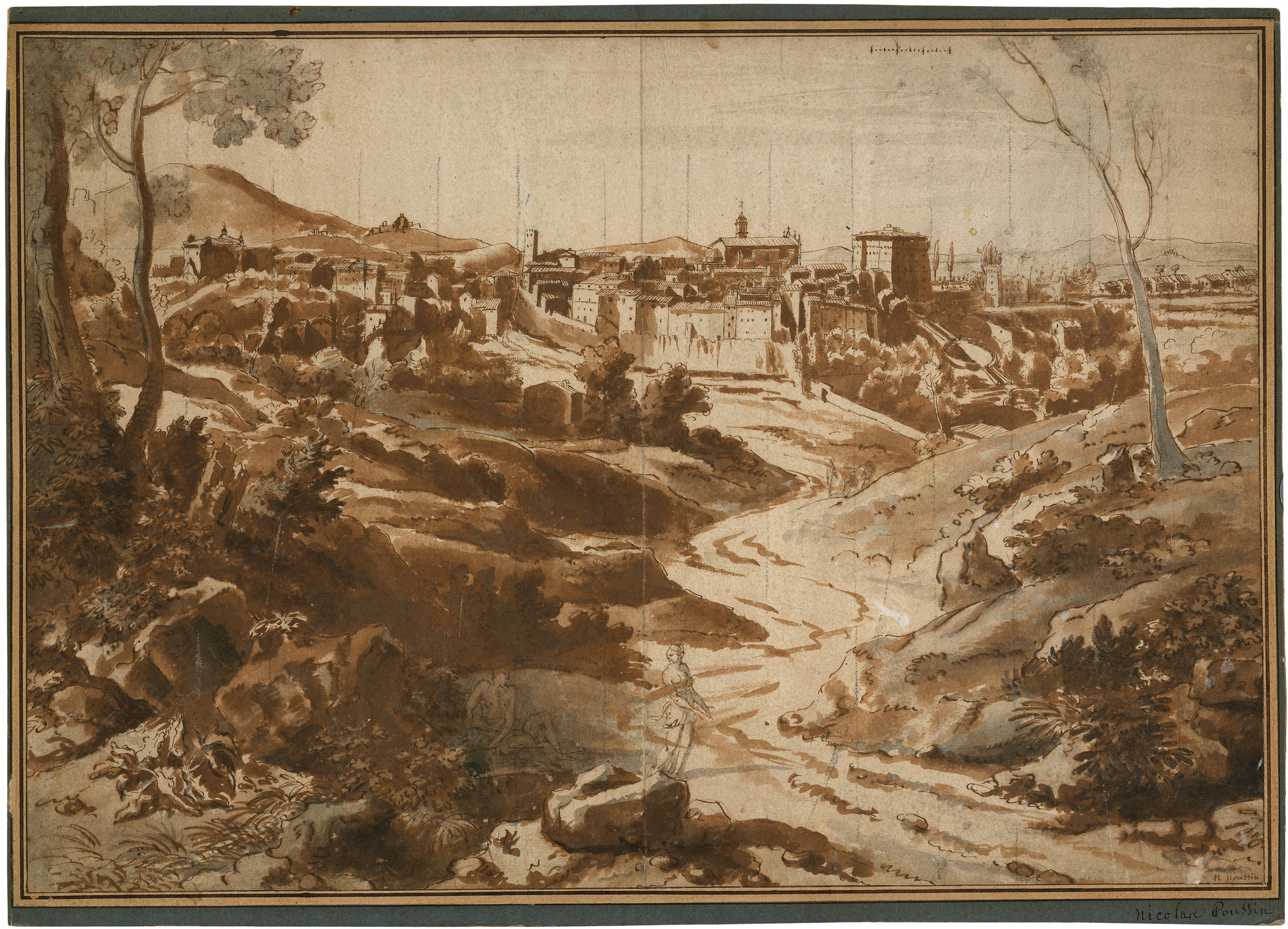Loading the page ...
Jan Frans van Bloemen
(called Orizzonte, 1662 Antwerp – 1749 Rome)
A Wide Campagna Landscape with a View of the Little Town of Vignanello. Pen and brown ink over a light preliminary drawing in black chalk, brown and grey wash, squared. 36.9 x 54 cm. With an old inscription in the lower right corner: n.poussin.
The rolling Campagna landscape is treated in a very fluid and sweeping style. The lightly sketched staffage figures in the foreground – a nymph and a reclining man clad only in a loincloth – lend the landscape an idealistic touch. Nevertheless, this is a topographically faithful rendering of a real place. The view is of the little town of Vignanello not far from Viterbo in the region of Latium. The skyline of the town has changed little to this day. Clearly visible on the right is the massive silhouette of Castello Ruspoli with its famous Baroque gardens.
The drawing is a genuine and striking example of the graphic art of the Antwerp-born painter and draughtsman Jan Frans van Bloemen. Bloemen started about 1680 as a pupil of Anton Goubau before moving on to Paris and finally in 1684 to Italy, where he was to remain until the end of his life. In Rome he joined the Bentvueghels club of Dutch and Flemish artists and received the nickname Orizzonte, which he adopted and later used to sign his work. Van Bloemen spent most of his time in Rome and the immediate vicinity of the city, where he flourished as a landscape painter. His high standing is attested by numerous works commissioned by noble Roman families, such as the Colonna, Doria Pamphilij and Ruspoli, and now to be found in their private collections. He was mentioned by his contemporaries in the same breath as artists of the calibre of Poussin and Gaspar Dughet, and in fact van Bloemen’s landscapes are stylistically very close to the works of Dughet. Like the latter, Orizzonte preferred to portray ideal landscapes with motifs from the environs of Rome, to which he added ancient ruins and religious or mythological staffage figures. Often the staffage elements were executed by fellow artists, such as Giuseppe Passeri, Pompeo Batoni and Placido Constanzi, or by his elder brother, Pieter van Bloemen.
While the surviving painted oeuvre is extensive, drawings by van Bloemen are rare. In many cases the artist evidently painted his landscapes directly onto the canvas without drawing any preliminary studies. The Busiri Vici catalogue lists only thirty-one works, most of them landscape sketches. Topographically faithful drawings hardly occur at all. Consequently the present impressive, large-format sheet is a major addition to the graphic oeuvre. The drawing, the spontaneity of which indicates it was probably done directly from nature, is a preliminary study for a painting now to be found in the Ruspoli Collection in Rome. It is characterized by Busiri Vici as “una delle tele più importanti e di maggiori dimensioni del van Bloemen”. The painting, which was probably produced around 1740, shows in the foreground a rich staffage consisting of a procession of coaches and riders led by Principe Ruspoli (see A. Busiri Vici, Jan Frans van Bloemen: Orizzonte e l’origine del paesaggio romano settecentescho, Rome 1974, no. 244).
This work demonstrates van Bloemen’s consummate style of drawing. The sweeping washes create stark chiaroscuro contrasts and a convincing suggestion of shimmering sunlight. Also of artistic interest is the varied treatment of the drawing. While the landscape in the foreground has been swiftly and succinctly portrayed with broad, deft strokes of the brush, van Bloemen has employed a careful pen technique for the topographically accurate rendering of the architecture. The subtly observed play of light and shade on the walls of the houses adds to the vividness of the scene.
Contact us for further information